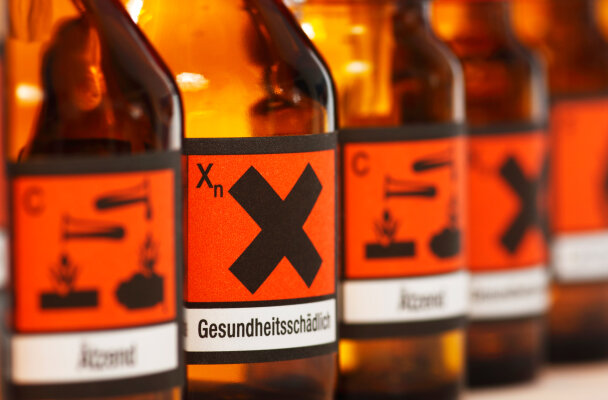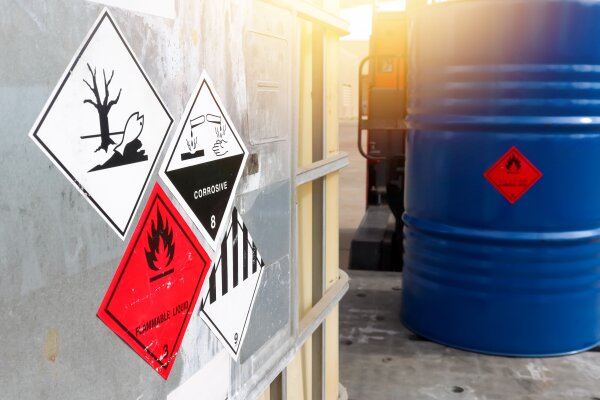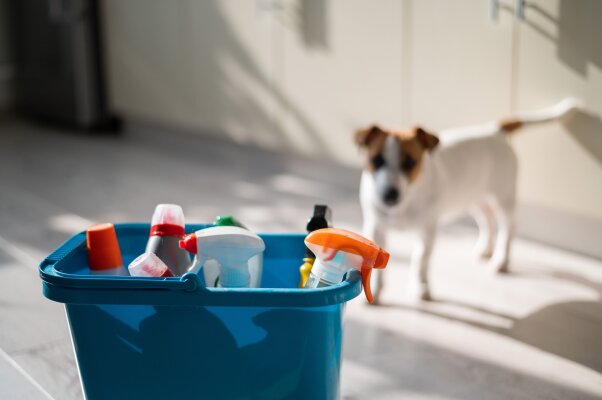Dangerous goods class 7: radioactive materials
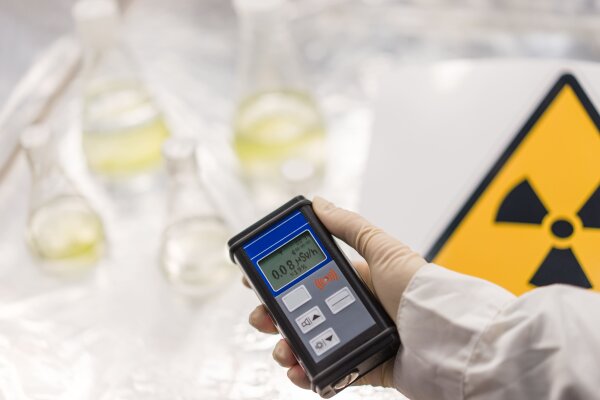
Dangerous goods class 7 includes substances and objects with radioactive materials. According to the Federal Office for Radiation Protection, around 420,000 people in Germany have to deal with these materials every year - think of X-ray equipment, for example. In this blog post, we have summarized how representatives of dangerous goods class 7 are defined, which subclasses there are and what to look out for during transport and in the event of damage.
Dangerous goods class 7: Definition
If we are talking about dangerous goods class 7, we are talking about all objects and substances with radioactive components and/or materials. Since radioactivity can neither be tasted nor smelled, these substances pose a particular danger. For example, they can alter human and animal DNA and cause serious damage to health if accidents occur during handling and use.
As a result, these substances differ from, for example, dangerous goods class 2 or dangerous goods class 3 in terms of their storage, transport regulations and packaging requirements.
Typical representatives of the 7th dangerous goods class are primarily uranium and plutonium, which can occur in several instruments and objects. These include, for example, medical instruments (such as X-ray equipment) and technical testing equipment used in production control.
Subclasses of radioactive substances
Especially in the storage and transport of radioactive materials, it is important to be able to make an assessment of the possible radiation. For this purpose, the objects and substances are divided into subclasses, the assignment and labeling of which are defined in the "UN Regulations for the Safe Transport of Radioactive Material" of the IAEA. The classification is based on the transport index (TI), which is determined from the respective dose rate of the substance.
Subclass 7: Category I White (7A)
This subclass includes the radioactive substances of category I, which are also known as "7A". They are characterized by the fact that the highest surface dose rate is below 0.005 mSv/h (millisievert per hour). This must be indicated on the outside of the packaging for packages. A transport code does not have to be indicated, but the following hazard label must be visible and filled in when shipping:
Subclass 7: Category II Yellow (7B)
Dangerous goods class 7B, on the other hand, includes category II radioactive substances that expose persons to external radiation and therefore pose a great danger, especially to people who work with them. For these substances, the exposure time must be limited in accordance with ADR instruction 5.4.3 in order to reduce a risk to persons. The surface dose rate for Group 7B is between 0.005 mSv/h and 0.5 mSv/h.
In contrast to dangerous goods category 7A, the transport index must also be specified, which must not be higher than 1.0. This category is also often referred to as Category II-Yellow and has a yellow hazard label.
Subclass 7: Category III Yellow (7C & D)
Subclasses 7C and 7D can be combined as Category III-Yellow, but entail different limits. For substances in dangerous goods class 7C, the radiation dose may be between 0.5 mSv/h and 2 mSv/h. Here, too, there are restrictions with regard to exposure time and hazards during substance ingestion. The transport index must not exceed 10.
Subclass 7D goes even further: the dose rate at the outside may be greater than 2 mSv/h, but may not exceed a value of 10 mSv/h. In return, the transport index may be higher than 10. In return, the transport index may be higher than 10. If substances and objects are transported with an "exclusive use" including certain additional requirements, on the other hand, the transport index is not limited. The dangerous goods labels for the two subclasses are as follows:
Division 7: Fissile materials (7E)
Subclass 7E has a special status because representatives of this category are fissile materials. For this reason, the class is given its own white hazard label, which contains the word "Fissile" and an additional safety note. In addition, the criticality safety index (CSI) must be included on the hazard label, which differentiates category 7E from the others. The hazard label can be found here.
Mandatory information for transport and traffic
Since radioactive materials pose a particular danger to people, the environment and other organisms, special precautions must be taken during transport. These include comprehensive transport documents as well as suitable packaging, labeling, documentation and qualified handling.
All these requirements are laid down in several UN recommendations and binding mode-specific legislation, including ADR (road transport), RID (rail transport), ADN/ADNR (inland waterway transport), IMDG Code (maritime transport) and ICAO-TI (air transport). The transport documents must contain the following information in particular:
- Address of the consignee
- UN number
- Number of the class of dangerous goods
- name and general description of the radioactive material
- Information on the radionuclides contained in the radioactive material
- Package category
- Package type
- Total radioactivity
- physical state and chemical formula
- Transport index (TI) and (if applicable) the criticality index.
- For packagings subject to approval: Marking of the approval authority
By the way, a pre-announcement is only necessary in international transport if the transport is a Type B package that exceeds certain maximum quantities. In this case, the packaging is marked (M) for multilateral or (U) for unilateral. Otherwise, advance notifications can also be worthwhile in the case of special agreements.
Details of the radioactive transport material
The safety classification for the transport of radioactive material also requires that specific information on the contents be provided. This helps to assess the hazard in the event of damage. This includes the following information:
- Name and symbol of the radionuclides
- Designation of the substance
- Physical and chemical form
- Maximum activity and total activity
- Criticality safety index
- Amount of cargo
Package categories
Packages are subject to several legal regulations and are categorized into five types. These are based on activity, toxicity and physical state as well as radioactive content. They are divided into excepted packages, industrial packages, and Type A, B, and C packages. In addition, each package is assigned a UN number for precise identification:
| Hazardous material class | Description | UN number |
| 7 | Excepted package, empty packaging (radioactive material) | 2908 |
| 7 | Radioactive material as excepted package in limited quantity of material | 2910 |
| 7 | Radioactive material as an excepted package as instruments or manufactures | 2911 |
| 7 | Type A package radioactive material | 2915 |
| 7 | Radioactive material of type A package in special form | 3332 |
Excepted packages
Although excepted packages must meet certain requirements, they represent packaging with such small quantities of radioactive materials that they are exempt from various regulations on use and design. It is important that the contents are recognizable when opened and that they cannot be damaged by impacts, shocks and the like.
Industrial shipments
If radioactive materials with a low specific activity (LSA) or surface contaminated objects (SCO) are to be transported, they are marked as industrial packages. Additional regulations govern the marking on the outside of the packaging and the entry in transport documents.
Type A Shipment Pieces
Type A packages are used as packaging for the transport of smaller quantities of radioactive material. These are required to remain intact in the event of "minor" incidents. Since parts of the contents may be released in the event of an accident, the maximum quantity of radionuclides is limited. Typical representatives are, for example, radiopharmaceutical products.
Type B shipping pieces
Larger quantities of radioactive materials, on the other hand, are assigned to the type B package. Even the most severe accidents must not be able to harm these packages, so that they are resistant even to puncture, immersion in water and fire. In particular, irradiated fuel elements, highly radioactive waste and radioisotopes are transported in this type of package.
Type C shipping pieces
Type C packages refer to a transport of radioactive materials by air. Above a certain activity, this type of packaging becomes necessary.
Packages with fissile material
In the case of fissile material, it must be prevented that a possible chain reaction can occur - this is what the package category for fissile materials stands for. Additional checks and inspections are also carried out, so that each type must be approved by the competent authority.
Dangerous goods class 7 marking
The scope of the required markings for Class 7 dangerous goods depends primarily on how they are transported and whether domestic or non-European destinations are served. For road transport, the ADR regulation (Agreement concerning the International Carriage of Dangerous Goods by Road) is decisive. On this legal basis, vehicles and packaging must be marked with:
- the UN number,
- a dangerous goods label,
- information about the consignor and consignee
- and the weight (if it exceeds 50 kg).
The dangerous goods label also includes the GHS symbol (Globally Harmonized System of Classification and Labelling of Chemicals) that applies to the substances in question. However, there is no direct equivalent for substances in dangerous goods class 7, so the typical radioactive symbol is printed:
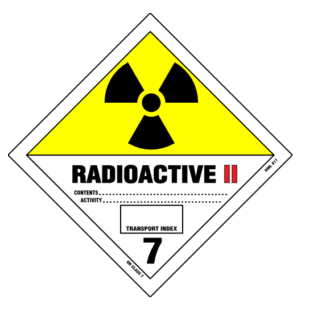
The correct handling of substances of dangerous goods class 7
To ensure that hazards from radioactive objects and substances can be contained as far as possible, attention must be paid to a number of important factors when handling them. For example, substances of dangerous goods class 7 may only be handled by qualified personnel who can ensure transport in accordance with the requirements of § 27 of the Radiation Protection Act (StrlSchG). This requires instruction for the transport of hazardous materials, covering at least the following contents:
- Legal basis for the transport of radioactive materials
- Important responsibilities
- Declaration and classification of substances
- General and special requirements for packages and package types
- Marking and identification of vehicles and packages
- Limits
- Necessary documentation
- Vehicle equipment
- Requirements for the vehicle driver
In addition, the packaging must meet the specified criteria of the package category. This means, for example, that the transport of damaged or leaking packages is generally excluded. In addition, there is shielding during loading, working hours around the radioactive materials reduced to a minimum, and contamination checks after each shipment.
Correct procedure in the event of an accident
If an accident should occur during the transport of radioactive materials, fast and targeted action is elementary. By classifying packages into categories, it is at least often possible to prevent radioactive radiation from escaping - even if the package has been shaken, punctured or even caught fire.
If an accident occurs, life-saving measures should be the first priority. However, these must be carried out with due regard for self-protection. Emergency services (police, fire department) must also be notified immediately of the nature and extent of the loaded goods. Persons must be removed from the danger area as comprehensively as possible and kept away.
In the case of radioactive cargo, the wind direction must also be taken into account in the event of damage - all persons should remain on the side facing the wind. Furthermore, cargo fires should never be extinguished by oneself and any incorporation (e.g. through eating, drinking and smoking) should be avoided at all costs.
Dangerous goods class 7: Correct handling of radioactive substances
Dangerous goods class 7 includes radioactive substances and objects that can harm both the environment and humans through radiation. Therefore, a correct classification into subclasses including labeling and strict precautions during transport are mandatory. Find out about all the legal basics before transport to be on the safe side - and to keep any potential risk as low as possible.
FAQ’s
Substances of the category "radioactive 7" belong to the goods of dangerous goods class 7, which is why they entail separate requirements for storage, transport, labeling and handling.
Dangerous goods class 7 includes all substances and objects that are radioactive or contain radioactive substances. This means that they have unstable atoms which can change their structure spontaneously and randomly. They also emit radiation. Well-known examples are above all uranium and plutonium.
Hazard classes are categories that classify chemical substances and mixtures with potentially hazardous properties. This plays an important role in transport in particular. According to ADR regulations, there are a total of nine classes of dangerous goods for transport by road.
Hazardous substances are mixtures, substances and articles with hazardous properties. These can have a negative impact on the environment and humans and meet the criteria of CLP Regulation No. 1272/2008.
Do you have questions about the topic or would you like to suggest a topic? Feel free to contact us by phone at +49 30 2096579 00 or send us an email at info@medsolut.com.

